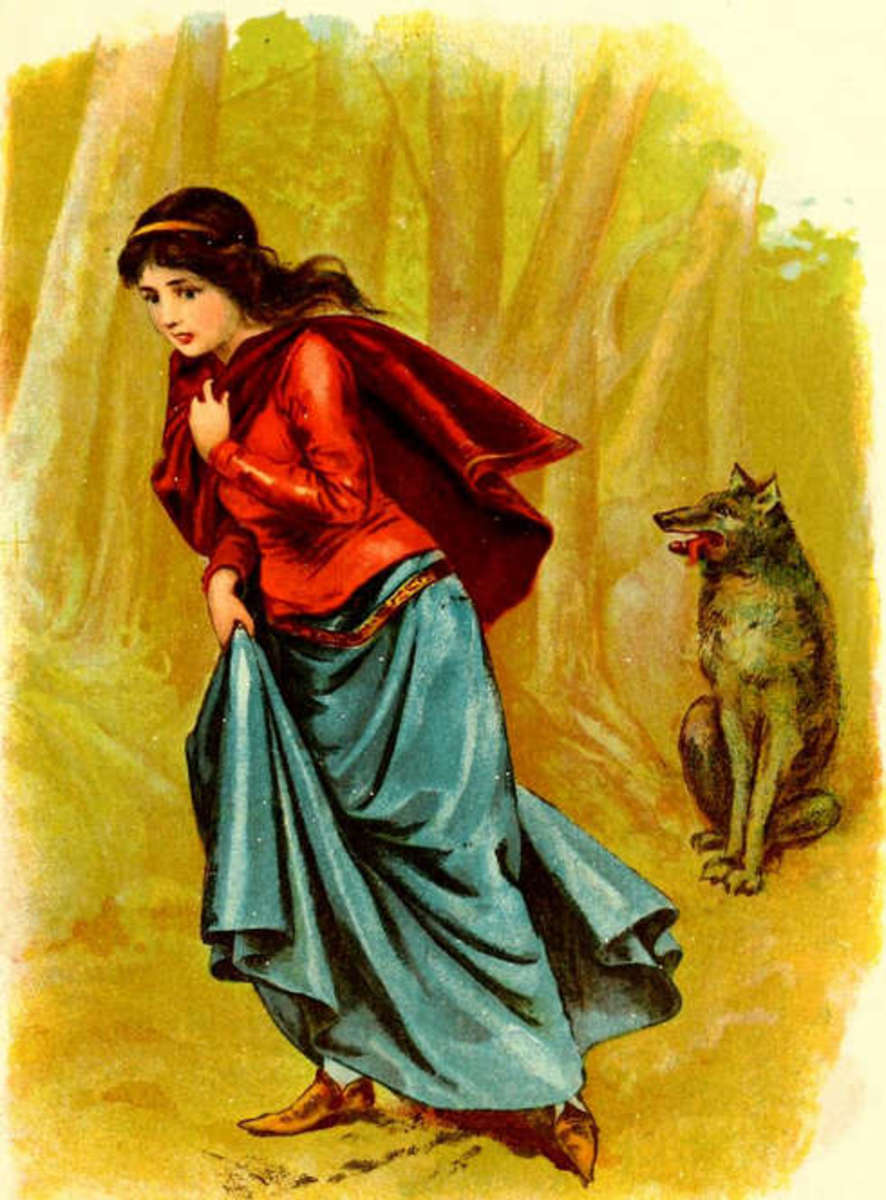- HubPages»
- Education and Science»
- Sociology & Anthropology»
- Folklore & Mythology
Recipe For Your Own Cautionary Tale
Some Favourite Urban Legends
Ingredients:
To make your own urban legend of the 'cautionary tale' variety, use the following ingredients:
For the Urban Legend 'sauce' - please prepare this ahead of time
- 1-Taboo Subject (something dangerous will do)
- 1-Creative Narrative (this can be very short)
- 1-Unpleasant Fate (this can be outrageous in scope)
Preparation:
Start with mention of the taboo subject early on. It only need be mentioned once to be effective. Mix in liberal amounts of narrative. If you've decided on a short version, just make pointed statements and keep sentences short. Tip for adding the 3rd ingredient...
No matter how outrageous your statements are about the 'unpleasant fate,' say them like you mean them or like you are quite aware of the unreasonable points of the statements, 'I know this sounds unbelievable, but...' or 'as incredible as it sounds, "..." happened!'
Additional Ingredients - to be prepared after the first three ingredients have been blended well and allowed to sit for a while:
- 1-group of 2-5 people (they don't have to be 'gullible') who enjoy discussion
- 1-campfire (optional)
- 1-cozy, indoor location where the lights can be turned low
Cautionary Tales/Urban Legends
What Urban Legend/Cautionary Tale Gets Under Your Skin?
Mix and Match Options - Taboo
Here are some 'taboo' topic options for you:
- * Polygamy - taboo in most Western societies
Your tale can involve the 'correction' of (the unpleasant fate of) someone found out to be a polygamist that you heard about in a nearby city
- * Vanity - someone's vanity (think of the 'Fatal Hairdo' tale)
Your tale can be about some person who comes to be harmed (unpleasant fate) due to vices of vanity. Harmed either by self or by someone exacting revenge over the person's vanity flaw
- * Parental Neglect
- something happens (unpleasant fate/conclusion) to the children of parents who are neglectful (think of "Humans Can Lick Too") or something awful happens to the parents who have neglected their child(ren). This one will be easy because you can say "I heard it happened in Canada" or "I heard this happened in a certain state USA." Some of the most bizarre but true things concerning parents and kids happen these days, so the taboo of parental neglect should be an easy one to both create a story about and capture listeners' attention!
- * Neglect of Safety
- someone gets killed or hurt or nearly killed or hurt because they forgot to do a basic task (think of "High Beams - Killer In The Back Seat").
This taboo/cautionary topic should also be very easy to build a great tale about. There are so many things storytellers can create into the 'accidents' to happen in a narrative, and no shortage of corresponding daily tasks that people SHOULD DO but forget or fail to do in order to maintain personal safety...
Double-checking the car door locks, double-checking the door locks of the house or apartment, remembering to turn off stove burners, making important phone calls before travelling, moving electric appliances away from water sources, being prepared in general so that one is not rushing through life and forgetting important details and tasks.
* USE AN OLD TABOO that is not necessarily 'politically correct' right now.
Go ahead and start your tale with something like, "I was reminded while talking to a friend the other day that women used to have no status as human beings back in the 1600's in '(pick a location - anywhere in the world will work if the date is far enough back).....here's what my friend told me he researched at the library about what used to happen to women back in those times...(insert old taboo topic early on)"
- * Cruelty To Animals - tell of some pet or other animal who gives 'payback' (unpleasant fate) to an abusive owner or person.
Pick your time to tell the tale!

Timing Counts!
For beginner storytellers wanting to veer into the eerie, slightly macabre pathway of urban legend tale-telling, a small group of listeners is perfect.
Even if you know the people well who you will tell your cautionary tale to, don't worry - you can still be effective, even if you don't normally tell stories of this variety. If you know the people well who will be your audience, this can actually be even more helpful to you as you might have some insight as to their likes, dislikes, etc.
If you've just been discussing 'current events' or local news with a small group of friends or even just two other people, THIS IS PERFECT, so that you can start to weave a bit of 'gossipy' theme around eventually to suit your cautionary tale topic.
The main thing to keep in mind is that once you begin your tale - GET ON A ROLL and do not stop until you reach the conclusion. Start off boldly with a statement such as:
"Wow, what you just said about that reminds me of something I recently heard about "(insert your taboo)."
or
Use foot-in-door techniques to set a reliable time for your tale with:
- "Just so I don't interrupt again - when you're finished your point, please remind me to tell you about a related topic of "insert taboo."
- "Your point is fascinating - when you're finished, please let me tell you about a similar thing I heard about "(insert taboo)"
- "This discussion is so interesting - let's finish it in whole, but remind me to tell you of something related that I heard about (insert a hint of the "unpleasant fate") as soon as we close this topic."
Once you're prepped, COMMIT yourself to telling the tale
Once it is the actual time to tell your cautionary tale, be committed to it and tell it all the way through - with all the embellishments, props and drama you intended to convey during your planning stages.
If it's a cautionary tale, elements of 'implausibility' are not going to matter much, so don't be too concerned about 'sounding dramatic' or being exact in your delivery.
Many of the best urban legends are suspiciously devoid of plausible time-lines, with story lines that travel along so quickly that listeners are often quite aware of 'missing pieces' of the story, however, if the 'formula' is right, listeners just want to keep listening to hear the conclusion.
Most people instinctively 'feel' the format of a cautionary tale or urban legend whether they are able to pinpoint this or not. Humans have a very curious need to hear frightful or potentially spooky stories, and most people love to listen to others tell stories.
If you're a beginner and this all seems uncomfortable to you, don't worry - you will improve with some practice.
HAVE FUN while you're doing this. It's supposed to be fun!
:)
The Narrative
Keep it simple
Introduce the taboo
Give a few details about who is involved in the narrative. It is best to keep 'character' number down to 3 or less, anyway, so you shouldn't get bogged down in 'character development' in the cautionary tale/legend you are creating.
Name a 'location,' but do not be too specific - don't mention a place ultimately well-known by your listeners (unless you are planning on using this as a 'scare tactic' on its own ie: "it happened right HERE 10 years ago!"). Tell the location of where the event(s) happened. If the location changes by the end of the tale, SKIP the 'travelogue' details and just get to the 'location' where the 'unpleasant fate' takes place.
Sometimes very short narratives are best because these allow each listener to use his or her own imagination in filling in ambiguous details.
Time-line jump around:
You can also 'jump around' in your narrative with, "oh, but before that happened, it is important to note that so-and-so had already found out about such and such thing." If you do this, immediately 'jump back' to your place-marker in the narrative. Don't 'jump around' with more than one detail at a time or this kind of distraction may collapse your story effects.
- A SINGLE 'jump around' works well in most short cautionary tale narratives. It is almost expected or can act as a seque at a point where you intentionally leave out a detail that will appear later in the conclusion as an 'ah-hah' effect or 'shocker' effect.
- Give your story a simple pattern like a very simple essay of one page. It takes about 5 minutes to read an average page and this is an appropriate amount of time to complete a fully decent cautionary tale.
- Go ahead and structure your new 'urban legend'/cautionary tale just like a mock essay - without formalities. You'll 'tell' this tale, anyway, rather than submit if for reader review.
Many people try to get too elaborate when trying to build stories. "Elaborate" belongs in books and in print usually, but for 'tale-telling,' conversational and layman's terms need be observed. Formality can add the effect of making a cautionary tale seem overly 'fake,' so that listeners are constantly reminded of 'format.'
The point here is NOT TO DEVELOP too much in your story - almost the opposite of writing a story for print of reader review!
Skip 'known' or 'assumable' details in your cautionary oral tale, just to shorten it down even more and make it seem more intense.
"Known" = "Perceived societal norms" such as:
- "parents should not leave children alone in a car," if you use this as a taboo, just say 'the parents left the child in the car,' You don't have to add "even though everyone knows this is a neglectful and even unlawful thing for parents to do."
- or - "the word 'convict' usually carries the most heightened 'bad connotation' with it - that of 'murderer," "madman," "killer" - so you don't have to specify 'murderer' or 'madman' most of the time if your story has a 'convict' in it. If you say 'convict,' you are BOUND TO maintain that term (for best results) throughout your story. Don't switch often between 'madman,' 'convict,' 'murderer,' 'serial killer,' etc, unless your tale is a long one and those details are absolutely necessary.
A very effective tactic is to ONLY mention the 'bad element' in a cautionary tale ONCE before revealing the 'unpleasant fate.'
Just mention once. Example:
For example, in the story of "The Hook," one super-effective and totally scary version of this cautionary tale only mentions the "Man Escaped From The Asylum" one time - via the radio broadcast - and in the narrative, the boyfriend immediately turns the radio OFF because it is interfering with his girlfriends' comfort level out at "Lovers Lane." In this version, much attention is placed on the girlfriend and boyfriend making out in the car and the girlfriend's continual checking out the windows, even though she never mentions what she is looking out the windows for (obviously, the escapee from the asylum). Lack of mention again of the words 'escaped,' 'asylum' and complete lack of use of the words 'killer' 'madman' in this version make for a totally explosive shock at the end.
Go ahead and write your tale out on paper, then read it aloud before presenting it to your audience. If you find ANYTHING in your paperwork that can be 'left out' and still allow the tale to make sense, pay particular attention to these details. Ask yourself, about these spots, "will my audience assume that point already?" and if so - leave a point out!
Allowing questions (even about severe discrepancies in your tale) to arise in the listeners' minds will usually turn out okay with storytelling, particularly in telling cautionary tales.
The Unpleasant Fate - Last Ingredient
On occassion, or whenever necessary - BE BLUNT!
Most cautionary tales have a HARSH, hard to hear ending.
Cautionary tales insist that there is a moral of the story - WITHOUT preaching about the moral of the story.
Be brief, too, if you can manage this. The unpleasant fate is best told in the final line of a cautionary tale. You can add a 'moral paragraph' or 'moral wrap up' to the oral cautionary tale, but make your 'unpleasant fate statement' then take a good, long pause...
Then add your 'afterword' or whatever you'd like to call it.
"Skinned Tom" is a neat example of the added last component, warning that Skinned Tom is still running around somewhere with a hunting knife, replicating what happened to him - to teach others a lesson about having sex with married ladies.
In "Skinned Tom" most versions have Tom as 'unaware' that his newest lover is married. This 'innocence' doesn't save Tom from being 'skinned' by the irate husband of his lover.
Also, the tale is one of the shortest effective cautionary tales. It is proof that no elaborate details are needed to impress an audience. Short tale, blunt statements, all action and progression of events quickly to the end of the tale.






